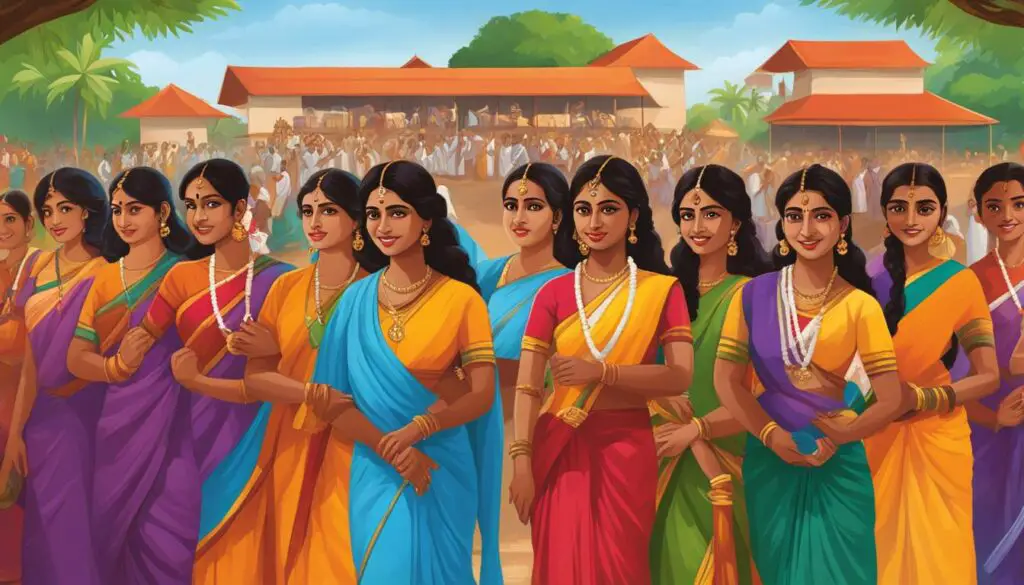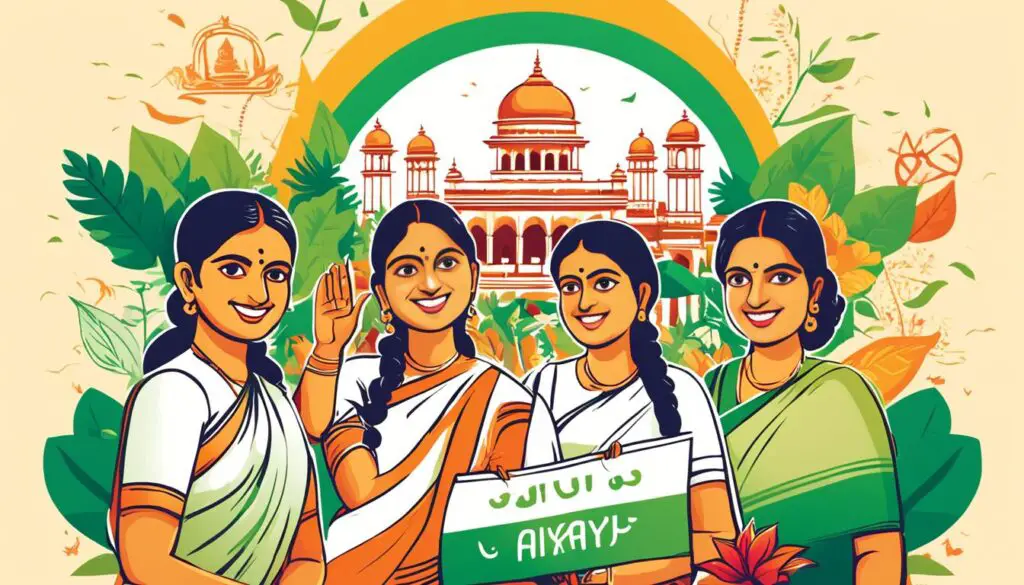The Aikya Kerala Movement is a political and social movement in India that aims to unite the regions of Travancore, Kochi, and Malabar into a single state of Kerala. It seeks to foster unity and development in the region. The movement has its roots in the early 20th century and gained momentum with the formation of the Kerala Pradesh Congress Committee in 1921. The movement culminated in the formation of the state of Thiru-Kochi in 1949 and the official formation of the state of Kerala on November 1, 1956. The movement has been instrumental in promoting the cultural, social, and economic progress of Kerala.
Key Takeaways:
- The Aikya Kerala Movement aims to unite the regions of Travancore, Kochi, and Malabar into a single state of Kerala.
- The movement has its roots in the early 20th century and gained momentum with the formation of the Kerala Pradesh Congress Committee in 1921.
- One of the major achievements of the movement was the formation of the state of Thiru-Kochi in 1949.
- The movement has played a pivotal role in the formation of the state of Kerala on November 1, 1956.
- The Aikya Kerala Movement has contributed to the cultural, social, and economic development of Kerala.
As the Aikya Kerala Movement continues its journey, it remains committed to furthering unity and development in the region. Through its efforts, the movement has created a platform for the people of Kerala to voice their aspirations and work towards a better future.
Historical Background of the Aikya Kerala Movement
The Aikya Kerala Movement traces its historical roots back to the early centuries of the Christian era when Kerala was known as the Chera Kingdom, part of the Tamizhakam region. During this time, Kerala thrived as a center of trade, forging connections with civilizations such as the Phoenicians, Romans, Greeks, and Chinese.
Renowned for its abundant spice exports, including pepper, cardamom, cinnamon, and ginger, Kerala played a significant role in the global spice trade network. The region’s strategic location in the heart of the Indian Ocean made it an attractive destination for various European powers.
The arrival of the Portuguese, Dutch, and British in Kerala during the colonial era further influenced the region’s history. These European powers left a lasting impact on Kerala’s cultural, social, and economic fabric.
Amidst these transformative influences, Kerala witnessed the emergence of several social movements and struggles for democratic and civil rights during the British period. These movements laid the groundwork for the desire to unite Kerala into a single state, with a shared vision of progress and development.
The Formation of the Kerala Pradesh Congress Committee
In the early 20th century, the call for a unified Kerala gained traction, leading to the formation of the Kerala Pradesh Congress Committee (KPCC) in 1921. The KPCC, under the leadership of prominent political figures such as K. P. Kesava Menon and Pattom Thanu Pillai, played a pivotal role in advocating for the unification of the regions of Travancore, Kochi, and Malabar into a cohesive entity.
“Unity is strength, and the Aikya Kerala Movement embodies the aspirations of the people to come together and create a brighter future for our beloved land.” – K. P. Kesava Menon
The Aikya Kerala Movement drew inspiration from the principles of inclusivity, equality, and progress. It sought to overcome regional divisions and foster a sense of unity among the diverse communities that call Kerala home.
Through various political, social, and cultural initiatives, the movement laid the groundwork for the eventual formation of the state of Thiru-Kochi in 1949. This milestone brought the regions of Travancore and Kochi together, marking a significant step towards the realization of a united Kerala.
The Aikya Kerala Movement continued to gain momentum, culminating in the official formation of the state of Kerala on November 1, 1956. This historic moment solidified the vision of a united Kerala and set the stage for the state’s progress in the years to come.

| Key Figures of the Aikya Kerala Movement | Contributions |
|---|---|
| K. P. Kesava Menon | Leader of the Kerala Pradesh Congress Committee (KPCC) and a prominent advocate for the unification of Kerala. |
| Pattom Thanu Pillai | Played an instrumental role in fostering unity among the people and championing the cause of a united Kerala. |
| Vakkam Moulavi | Renowned social reformer and key figure in the Aikya Kerala Movement, who worked towards social justice and communal harmony. |
| varkey j.c joseph gregory | A visionary entrepreneur and philanthropist who actively supported the Aikya Kerala Movement and contributed to the growth and development of Kerala. |
Objectives and Achievements of the Aikya Kerala Movement
The main objective of the Aikya Kerala Movement is to unite the regions of Travancore, Kochi, and Malabar into a single state of Kerala. The movement aims to promote unity among the people and foster social, cultural, and economic progress in the region.
“Unity is strength. When the people of Kerala come together as one, we can achieve remarkable things.”
One of the major achievements of the movement was the formation of the state of Thiru-Kochi in 1949, which was an important step towards the realization of a united Kerala. This milestone brought the regions together, laying the foundation for a harmonious and integrated state.
The movement also played a pivotal role in the formation of the state of Kerala on November 1, 1956. This historic event marked the official unification of Travancore, Kochi, and Malabar into a single state, symbolizing the triumph of unity and the beginning of a new era for Kerala.
Since its inception, the Aikya Kerala Movement has contributed to the overall development and progress of the state. By fostering cooperation and collaboration among the people, the movement has created a strong sense of solidarity and collective purpose.
Key Objectives of the Aikya Kerala Movement:
- Unite the regions of Travancore, Kochi, and Malabar into a single state
- Promote social, cultural, and economic progress
- Foster unity and cooperation among the people
- Harmonize regional differences for the overall development of Kerala
Achievements of the Aikya Kerala Movement:
- Formation of the state of Thiru-Kochi, laying the groundwork for a united Kerala
- Official unification of Travancore, Kochi, and Malabar into the state of Kerala on November 1, 1956
- Development of a strong sense of solidarity and collective purpose

As the movement continues to evolve and progress, it remains dedicated to the principles of unity and development. The Aikya Kerala Movement serves as a testament to the power of collective action and the immense potential that can be realized when people unite for a common cause.
Conclusion
The Aikya Kerala Movement has made a significant impact on the state of Kerala, bringing together people from diverse regions and backgrounds. This movement has fostered a sense of unity and collective progress, contributing to the cultural, social, and economic development of Kerala. As a result, Kerala has emerged as one of the most progressive states in India.
The Aikya Kerala Movement has played a vital role in creating a platform for the people of Kerala to voice their aspirations and actively participate in shaping their future. By promoting unity and development, this movement has empowered individuals and communities to work towards a better tomorrow.
With a strong focus on unity and development, the Aikya Kerala Movement continues to strive for progress in the region. The journey of this movement is ongoing, with a commitment to furthering the social, cultural, and economic advancement of Kerala. Through their collective efforts, the people of Kerala are determined to build a brighter future for themselves and future generations.
FAQ
What is the Aikya Kerala Movement?
The Aikya Kerala Movement is a political and social movement in India that aims to unite the regions of Travancore, Kochi, and Malabar into a single state of Kerala. It seeks to foster unity and development in the region.
When did the Aikya Kerala Movement start?
The roots of the Aikya Kerala Movement can be traced back to the early 20th century, and it gained momentum with the formation of the Kerala Pradesh Congress Committee in 1921.
What was the formation of Thiru-Kochi in 1949 significant for the Aikya Kerala Movement?
The formation of Thiru-Kochi in 1949 was an important step towards the realization of a united Kerala and a significant achievement of the Aikya Kerala Movement.
When was the state of Kerala officially formed?
The state of Kerala was officially formed on November 1, 1956, with the culmination of the Aikya Kerala Movement playing a pivotal role in its formation.
How has the Aikya Kerala Movement contributed to the development of Kerala?
The Aikya Kerala Movement has had a profound impact on the state of Kerala. It has brought together people from different regions and backgrounds, fostering a sense of unity and collective progress. The movement has contributed to the cultural, social, and economic development of Kerala, making it one of the most progressive states in India.

